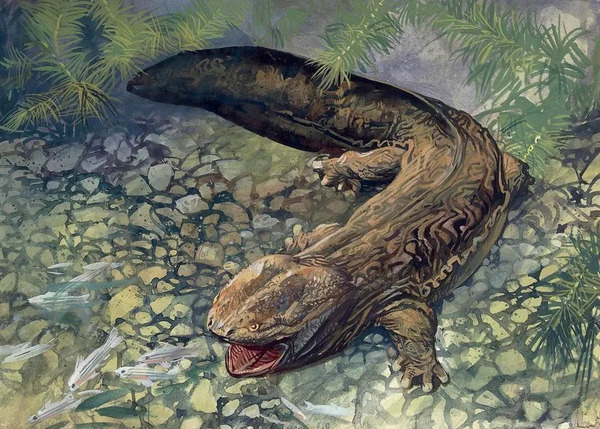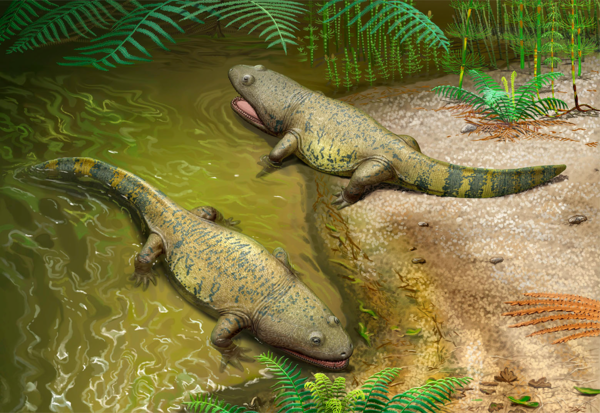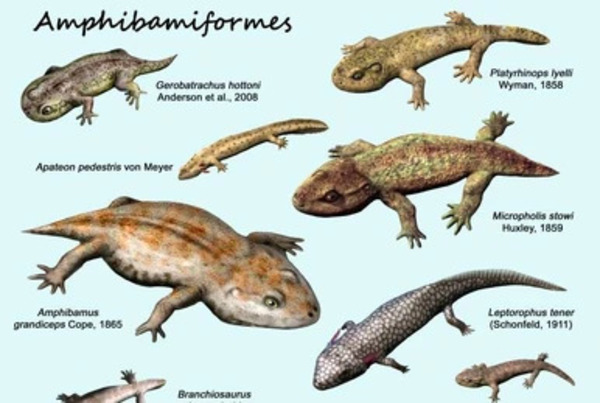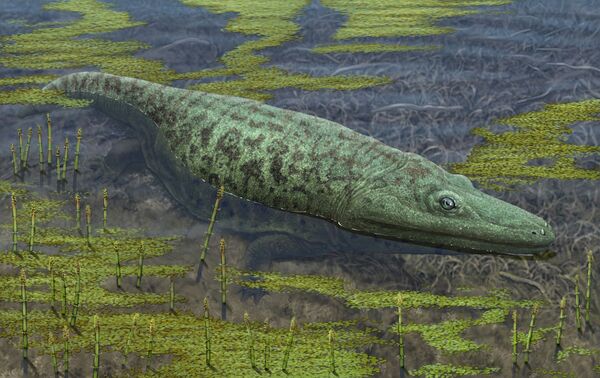Prehistoric amphibians offer a fascinating glimpse into the evolution of life on Earth, showcasing an array of incredible creatures that dominated swamps and wetlands long before dinosaurs walked the planet. Many of these ancient amphibians are now extinct, but scientists study their fossils to better understand how life evolved. In this article, we’ll dive into a few extraordinary prehistoric amphibians that start with the letter “M.” These creatures were early representatives of the amphibian lineage, blending traits of fish and terrestrial animals, and they were vital steps in the development of vertebrates as we know them today.
Overview: Megalobatrachus is a name that resonates with power. Meaning "giant frog," this genus is believed to resemble modern giant salamanders but on a much larger scale.

Characteristics: These creatures were massive, even compared to modern amphibians. Like today’s giant salamanders, they had wide, flat bodies, a large head, and sturdy limbs for moving through murky swamp waters.
Habitat and Lifestyle: Thought to inhabit freshwater environments like lakes and rivers, Megalobatrachus might have spent much of its life underwater, hiding among rocks and ambushing smaller animals.
Evolutionary Significance: Megalobatrachus is significant because it provides insight into the size range of ancient amphibians and offers a comparison to how some amphibian traits have persisted into the modern era.
Overview: Metoposaurus was one of the most iconic amphibians of the Triassic period, about 210 million years ago. Its name means “front lizard,” but don’t let the name fool you—Metoposaurus was a distinct member of the amphibian family.

Characteristics: This creature had a broad, flat skull with eyes positioned near the top of its head, allowing it to stay submerged while scanning its surroundings. Metoposaurus was relatively large, reaching up to 3 meters (10 feet) in length.
Habitat and Lifestyle: Primarily an aquatic animal, Metoposaurus lived in swampy wetlands and slow-moving rivers. Its diet likely consisted of fish and smaller aquatic organisms, which it would snap up with its wide mouth.
Evolutionary Significance: As a member of the temnospondyl group, Metoposaurus is considered one of the ancestors to modern amphibians. Its fossil record helps scientists understand how amphibians adapted to and thrived in waterlogged environments.
Overview: Micromelerpeton was a small to medium-sized prehistoric amphibian that lived during the late Carboniferous to early Permian period, around 300 million years ago. Its name translates to “small crawling animal,” which fits its appearance and lifestyle.

Characteristics: Unlike some of its larger relatives, Micromelerpeton was more modest in size. It had a long, slender body, short limbs, and a tail suited for swimming. Its bones show adaptations for both water and land, indicating a semi-aquatic lifestyle.
Habitat and Lifestyle: Micromelerpeton inhabited freshwater lakes and rivers. It was likely an agile swimmer that fed on insects and smaller aquatic creatures.
Evolutionary Significance: Micromelerpeton’s dual ability to live in water and on land highlights the transition amphibians were making toward terrestrial living, a crucial step in vertebrate evolution.
Overview: Mastodonsaurus was one of the largest amphibians ever, ruling the late Triassic period around 230 million years ago. Its name means "breast-tooth lizard" due to its characteristic tooth shape.

Characteristics: Measuring up to 6 meters (20 feet), Mastodonsaurus had a massive skull and a body resembling a giant salamander. Its large, powerful jaws and fang-like teeth made it a formidable predator.
Habitat and Lifestyle: This amphibian inhabited rivers and marshlands, where it would wait to ambush prey, such as fish or smaller amphibians. With its huge size and powerful bite, it was likely at the top of the food chain.
Evolutionary Significance: Mastodonsaurus provides insight into the evolutionary trend toward larger body sizes in amphibians, a trend seen in response to an environment rich in prey but with few large predators.
Overview: Mazonerpeton is named after the famous Mazon Creek fossil site in Illinois, USA, where its fossils were first discovered. This prehistoric amphibian lived during the Carboniferous period, around 300 million years ago.
Characteristics: Mazonerpeton was relatively small compared to some of its relatives, with a slender body and a long tail. It is thought to resemble a modern salamander, with adaptations that allowed it to move both in water and on land.
Habitat and Lifestyle: Found in coal swamps, Mazonerpeton likely led a semi-aquatic lifestyle, feeding on insects, small fish, and other invertebrates. Its limbs suggest it was a good climber, possibly moving through dense vegetation near the water’s edge.
Evolutionary Significance: Mazonerpeton is crucial for understanding the diversity of early amphibians and how they adapted to various ecological niches. Its fossilized remains offer a glimpse into the early evolution of terrestrial vertebrates.
The prehistoric amphibians that start with “M” tell a unique story about how early vertebrates evolved. These creatures adapted to diverse environments and, over millions of years, gave rise to the modern amphibians we see today. By studying them, scientists gain valuable insight into the challenges and adaptations required for life on land. Amphibians, as some of the first vertebrates to live outside water, paved the way for reptiles, mammals, and eventually humans.
What were some of the largest prehistoric amphibians?
Mastodonsaurus was among the largest, reaching up to 20 feet in length.
Are any modern amphibians related to these prehistoric species?
Modern amphibians share a distant ancestry with creatures like Metoposaurus and Mazonerpeton, though none are direct descendants.
Where can I see fossils of these prehistoric amphibians?
Fossils can be found in various museums and natural history sites worldwide, especially in locations known for Triassic and Permian fossil beds.
By exploring these ancient marvels, we gain a better understanding of life’s resilience and adaptability through the ages. The prehistoric amphibians that start with "M" offer more than just an evolutionary lesson; they give us a sense of wonder about Earth's rich natural history.
Overview
Metoposaurus, meaning “front-faced lizard,” was a large, broad-headed amphibian that roamed the wetlands of what is now Europe and North America during the Late Triassic period, around 210 million years ago. This genus is one of the most iconic members of the temnospondyls, a group of large, semi-aquatic amphibians that flourished before the rise of dinosaurs.
Physical Characteristics
Metoposaurus could reach lengths of up to 10 feet (3 meters) and had a flat, wide skull that occupied a significant portion of its body length. Its head was unusually large, comprising up to 20% of its total body length, and featured a broad, almost flattened shape with eyes located on top of the skull. This eye placement allowed Metoposaurus to remain submerged while keeping an eye on its surroundings, similar to how modern-day crocodiles behave. The body itself was comparatively slender, with short, paddle-like limbs suited for swimming but not for prolonged movement on land.
Habitat and Lifestyle
Metoposaurus thrived in the vast river systems, marshes, and lakes of the Late Triassic. Its powerful, muscular body allowed it to swim skillfully, but its anatomy suggests it was more of a bottom-dweller than an active swimmer. As an ambush predator, it likely lurked in shallow waters, waiting for fish or smaller amphibians to pass by before snapping them up with its wide jaws. Given the abundance of similar temnospondyl amphibians during this time, Metoposaurus faced stiff competition for food but held an advantage due to its size and ambush tactics.
Evolutionary Significance
Belonging to the Temnospondyli clade, Metoposaurus is an important study subject in understanding amphibian evolution. Temnospondyls are regarded as distant ancestors of modern amphibians, with species like Metoposaurus representing some of the last and largest of this lineage. Its fossils provide insight into the environmental pressures and adaptive responses amphibians underwent during the Triassic, especially as climates became increasingly arid.
Overview
Named after the Mazon Creek fossil beds in Illinois, USA, Mazonerpeton lived during the Carboniferous Period around 300 million years ago. The Mazon Creek beds are renowned for preserving delicate soft tissues, giving scientists an incredible window into the lives of these ancient creatures. As a small and agile amphibian, Mazonerpeton was well-adapted to the dense, humid forests of the Carboniferous, teeming with plant life, insects, and small vertebrates.
Physical Characteristics
Mazonerpeton was a relatively small amphibian, only about a foot in length. Its body was slim and flexible, with a lengthy tail and small but robust limbs that indicate both swimming and climbing capabilities. Its morphology is similar to that of modern salamanders, showing adaptations for a dual lifestyle in water and on land. Its teeth suggest it was likely an insectivore, preying on small invertebrates that inhabited the forest floor and water’s edge.
Habitat and Lifestyle
Mazon Creek’s swampy, coal-rich environments were ideal for Mazonerpeton, which likely spent time in the moist leaf litter, hunting insects and small arthropods. Unlike larger, semi-aquatic amphibians of the period, Mazonerpeton may have been quite nimble and able to climb on low plants or branches, avoiding larger predators while seeking food. This ability to thrive in both water and on land would have given it a unique survival advantage in the dense, competitive ecosystems of the Carboniferous.
Evolutionary Significance
Mazonerpeton belongs to a lineage that hints at the diversity of early amphibians. Its morphology bridges some of the gaps between the aquatic temnospondyls and the more land-oriented stem tetrapods that would later give rise to reptiles. Studying Mazonerpeton helps scientists understand the progression of limb development, respiratory adaptations, and dual-terrestrial-aquatic lifestyles that would become essential in later vertebrates.
While both Metoposaurus and Mazonerpeton were significant in early amphibian evolution, they represent very different adaptations and periods:
Time Periods: Metoposaurus is from the Late Triassic, while Mazonerpeton hails from the Carboniferous, underscoring different stages in amphibian evolution.
Size and Morphology: Metoposaurus was a large, semi-aquatic predator with a broad, flat head ideal for ambushing, whereas Mazonerpeton was small, nimble, and adapted for both water and limited climbing.
Habitat Specialization: Metoposaurus was a true swamp ambusher, while Mazonerpeton was agile and possibly adept at navigating dense vegetation.
By studying creatures like Metoposaurus and Mazonerpeton, paleontologists continue to uncover the adaptive strategies that allowed early amphibians to diversify and eventually give rise to reptiles, mammals, and birds. These creatures, both large and small, demonstrate the evolutionary creativity that flourished in Earth’s ancient wetlands.
animal tags: Mazonerpeton
We created this article in conjunction with AI technology, then made sure it was fact-checked and edited by a Animals Top editor.